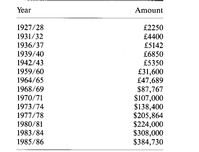


Chapter 8
I Part 1: Communications
i Before the Telegraph
ii Electrical Communication Before Federation
iii Federation to the End of the Second World War
iv Post-war and on to 1975
v 1975 ONWARDS
II Epilogue
III Part 2: Early Australian Computers And Computing
IV Acknowledgements
References
Index
Search
Help
Contact us

1975 ONWARDS (continued)
In addition to leading the way in many features of the satellite system design, Australia is the first nation in the world to utilize the B-MAC modulation scheme for the delivery of the Homestead and Community Broadcast Satellite Service and RCTS broadcasting material. Unlike the PAL system used for the terrestrial broadcasting of television, the B-MAC (B-type Multiplexed Analogue Components) signal format is designed for transmission over FM systems and particularly via satellites. The B-MAC format is used in HACBSS to provide a television programme with stereo sound, one stereo and two mono radio programmes, a continuous 9.6 kbit data stream and numerous ancillary services such as teletext. Each HACBSS receiver will require a B-MAC decoder which will produce outputs for either a conventional PAL receiver or an RGB monitor and a conventional stereo system. The decoders are all uniquely addressable -a feature which can be used for receiving personal messages, broadcasting messages to a group of receivers in known locations (for purposes such as cyclone warnings) and for pay television services should these become available.Satellite technology will also influence distance education. As one example, the Mt. Isa School of the Air has begun trials with the Aussat system with equipment which provides high quality two-way voice and data communications between the teacher and the students, with a video broadcasting capability which can be used to present additional material for study. Each student has a terminal with a video monitor and a personal computer for teacher/student and student/student interactions. The School of the Air system based on HF radio and postal delivery, which has served remote areas for many years, is unreliable as to technical quality and necessarily slow in response time.
Work of stimulating research in tertiary institutions under the auspices of the RRB continued through this period, with funding as set out in Table 9. In 1977 the first of a notable series of RRB workshops on optical communications was sponsored by the University of NSW, bringing research workers in this field together on an annual basis and exposing the latest developments both in Australia and overseas. The third post-doctoral fellowship was awarded to Dr. R. Sammit, who took up an appointment at the ANU on theoretical studies concerning optical communications.

With a decline in the number of postgraduate students in Electrical Engineering, the RRB instituted a system of postgraduate fellowships in 1981. Influenced by the changing nature of technology, the board decided in 1985 to change its name to the Australian Telecommunications and Electronics Research Board.
Meanwhile, reflecting the growing impact of computer sciences, the desirability of establishing an Australian Computer Research Board (ACRB) was raised, resulting in the establishment of such an organisation funded by CSIRO, Defence Department, Telecom and OTC in 1981, with initial funding of $130,000 per annum. The objectives of the ACRB were:
- To foster research and development in computer engineering and computer science, including the application of this research and development in universities and other appropriate organisations;
- to assist in improving the training of computer engineers and scientists and to attract into the field the high calibre graduate;
- to encourage interaction between universities, government, industry and other interested bodies.
Organisations in Australian Science at Work - AUSSAT; Australia. Department of Defence; Australian Computer Research Board (A.C.R.B.); Australian Telecommunications and Electronics Research Board; CSIRO; Homestead and Community Broadcast Satellite Service (H.A.C.B.S.S.); Mount Isa School of the Air; Overseas Telecommunications Commission (O.T.C.); Radio Research Board; Telecom Australia (Australian Telecommunications Commission)
People in Bright Sparcs - Sammit, Dr R.
 |
Australian Academy of Technological Sciences and Engineering |  |
© 1988 Print Edition pages 607 - 608, Online Edition 2000
Published by Australian Science and Technology Heritage Centre, using the Web Academic Resource Publisher
http://www.austehc.unimelb.edu.au/tia/580.html